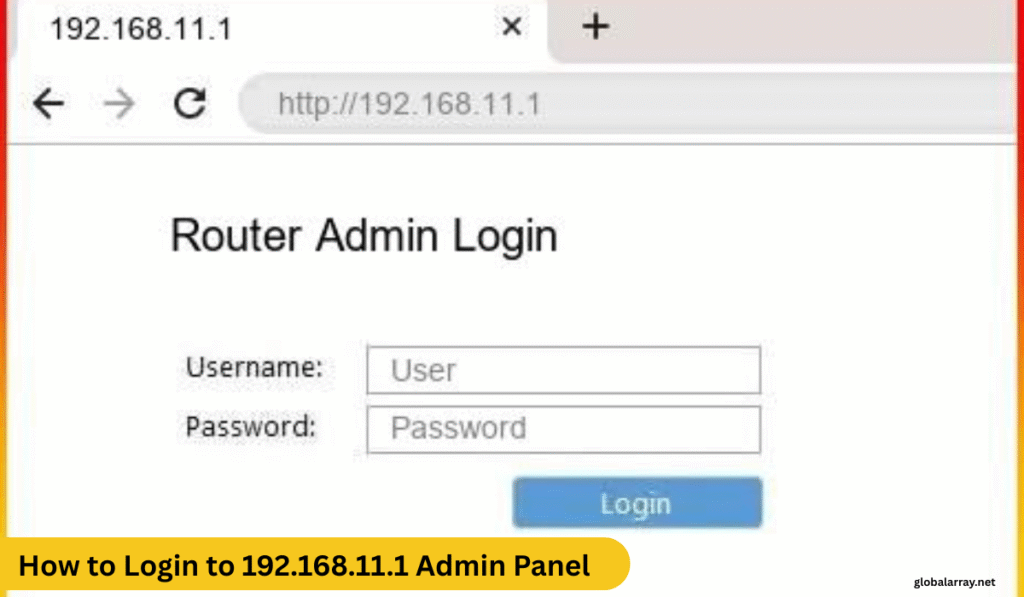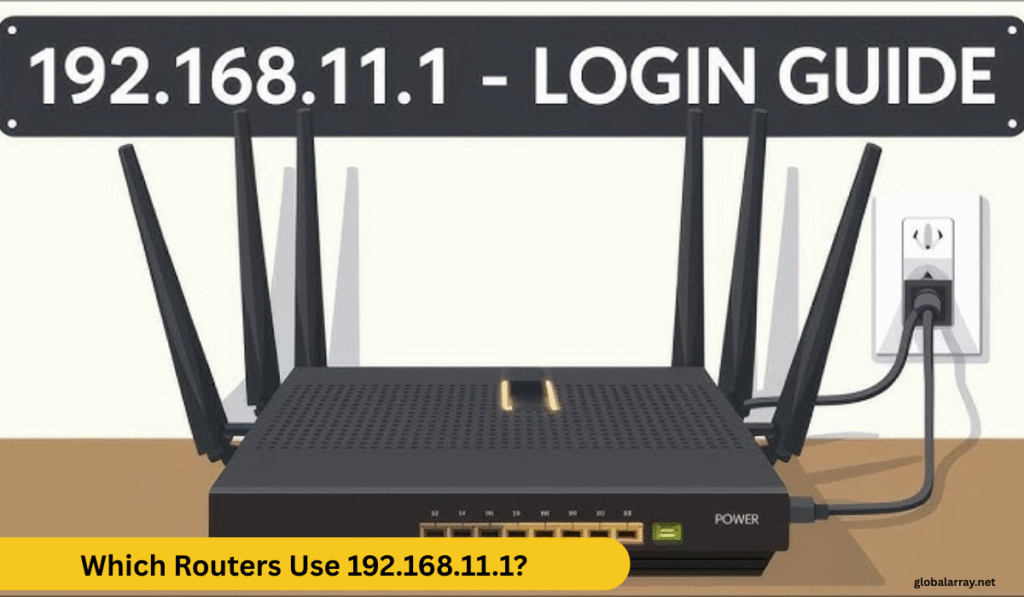Router Connection Checker
• Local-only test
• No redirects or logins
• Works in real-time
What is 192.168.11.1 and Why Do People Use It?
192.168.11.1 is a special number called an IP address that some routers use to open their settings page. You can type it into a web browser to change your Wi-Fi name, password, or other options. It only works at home or in small networks, not on the internet, which helps keep things safe.
What Is a Private IP Address?
A private IP address is a number used inside your home or office to connect your devices. It’s not shown on the public internet. 192.168.11.1 is one of these addresses. This helps keep your network safe and avoids problems with other networks.
How It Helps with Router Settings
When you enter 192.168.11.1 in your browser, it opens your router’s settings. From there, you can:
- Change your Wi-Fi name or password
- Turn on guest Wi-Fi
- Update your router software
- Block websites for kids
This IP helps you manage everything your router does.
How to Login to 192.168.11.1 Admin Panel

To login to the 192.168.11.1 admin panel, the first step is to ensure that your device is connected to the network. If you’re using a wired connection, plug an Ethernet cable into your router and computer. For wireless access, make sure your Wi-Fi is enabled and connected to the router. Next, open any browser on your computer and type 192.168.11.1 into the address bar. You may be redirected to the login page.
On the login screen, enter the default username and password for your router. These credentials are usually found on the router sticker or in the manual that came with your device. If you’ve changed the default credentials, make sure you enter the correct details. After inputting the right information, press the login button to access the router’s settings.
Steps for Windows, Mac, and Mobile Devices
| Device | Steps |
|---|---|
| Windows | Make sure you have a stable internet connection. Open any browser and enter 192.168.11.1. Check your username and password. If it doesn’t load, clear your browser cache or restart your device. |
| Mac | Confirm you’re connected by checking System Preferences. Open Safari or another browser and go to 192.168.11.1. If it doesn’t work, restart your Mac, double-check your login info, or update the router firmware. |
| Mobile | Launch your mobile browser and enter 192.168.11.1. If it doesn’t open, update your browser, clear its cache, or check your app permissions. You can also disable unnecessary apps or review your network settings. |
Common Login URL Errors
When logging into the 192.168.11.1 admin panel, several common errors may occur. Here’s a quick guide to help troubleshoot these issues:
- 400 Bad Request: This happens when the URL is malformed or the parameters are incorrect. Double-check that the typed URL is correct, with no extra spaces or characters. Ensure you’re using http or https as needed.
- 403 Forbidden: This error typically occurs when there is a permission issue, such as not having the right login credentials or insufficient access rights. Verify your credentials and ensure that you’re authorized to access the router’s settings.
- 401 Unauthorized: This error indicates a problem with authentication. Make sure you’ve entered the correct username and password for the router login. If the login details are incorrect, reset them if possible.
- Clear Cache and Cookies: Stored browser data can sometimes cause issues with login. Clear the cache and cookies from your browser to make sure you’re not using outdated or incorrect information.
- Switch Browser: If you’re still facing issues, try switching to a different browser to rule out browser-specific problems. Sometimes, switching from Google Chrome to Mozilla Firefox or Microsoft Edge can resolve errors.
Browser Compatibility Tips
When trying to access the 192.168.11.1 admin panel, using a modern browser is crucial. Sometimes, older browsers may not support all the required web functionalities. To ensure a smooth experience, try Google Chrome, Mozilla Firefox, or Microsoft Edge. These browsers are known to work well for accessing router settings and display issues are rarely encountered. Additionally, make sure that JavaScript is enabled in your browser, as many router configurations need it to function properly.
Also Read Our Article: Find IP Address of Website Simple Guide with Easy Ways
Default Username and Password for 192.168.11.1
| IP Address | Username | Password | Success Rate |
|---|---|---|---|
| 192.168.11.1 | blank | root | ★★★★☆ (38%) |
| 192.168.11.1 | admin | password | ★★★★☆ (38%) |
| 192.168.11.1 | admin | admin | ★★☆☆☆ (12%) |
| 192.168.11.1 | 1234 | root | ★☆☆☆☆ (4%) |
| 192.168.11.1 | root | password | ★☆☆☆☆ (4%) |
Default Credentials by Popular Router Brands
| Brand | Default Username | Default Password | Notes |
|---|---|---|---|
| TP-Link | admin | admin | Used for most models |
| Netgear | admin | password | Try with all lowercase |
| D-Link | admin | (leave blank) | Some models have no password |
| Linksys | admin | admin | Older models |
| ASUS | admin | admin | Change after setup recommended |
Troubleshooting 192.168.11.1 Login Problems
When you’re logging into your router through the IP address 192.168.11.1, there can be a few network and connectivity problems that stop you from accessing the router’s settings. One of the most common issues is entering incorrect login credentials. Make sure you’re using the default username and password, often printed on a sticker on the router. If the default credentials don’t work, it’s possible that they were changed during the configuration process. In this case, you may need to reset the router to its factory settings and try again.
Page Not Loading or IP Not Found
Sometimes, when trying to open 192.168.11.1, the page just won’t load, or your browser says the IP can’t be found. From my own experience handling dozens of home networks, this often comes down to something as basic as a loose Ethernet cable or a misconfigured device. First, check if your router is powered on and that the cable is firmly plugged into both the router and your computer. A faulty connection can block your access to the administrative console entirely.
Check Cable or WiFi Connection
If you’re trying to access your router using 192.168.11.1 and nothing’s loading, don’t rush into resets. First, make sure the Ethernet cable is firmly plugged into both your device and the router. I’ve often helped clients who overlooked a loose connection, thinking something was wrong with their hardware. Even on Wi-Fi, a weak signal can stop you from reaching the router’s administrative interface.
Also, double-check if your system is actually trying to connect to the router’s console and not some other network. A good trick I’ve used is switching to a wired connection temporarily—it bypasses signal drop issues and helps verify that the hardware and settings are working properly. You’d be surprised how often a simple console reload after a stable cable hookup gets you back into the admin panel.
Verify the Correct IP Address
Sometimes no matter what you try, nothing seems to work while logging into your router using 192.168.11.1. One thing that has often worked for me when all else fails is simply pressing the tiny reset button on the back of the router. This may seem basic, but it’s often the best bet when the configuration becomes unresponsive or the login screen won’t load. Just keep in mind, doing this will wipe all your custom settings, including the Wi-Fi name and password. So before you go ahead, backup the current setup if possible.
After resetting, give the device a minute or two to reboot and return to factory settings. It’s like giving your router a clean slate. I’ve had to revert routers this way plenty of times during client visits when even experts couldn’t get in. Once it’s done, try to turn it back on and access it again through the default IP. If everything is set up correctly and the default configuration loads, you’ll know it’s okay to proceed and reapply your personalized changes.
Restart or Reset Your Router
If your router login page at 192.168.11.1 refuses to load or keeps giving errors, one of the best moves I’ve found is to simply restart the device. A quick reboot clears temporary glitches and often restores connection instantly—no waste of effort. But if the login still fails, then a reset might be the next step. Press and hold the small reset button on your router to revert it back to factory settings. Just keep in mind this will wipe all previous configuration and you’ll have to log in again using the default credentials printed on the label. I always make sure to backup settings before doing this, in case I want to restore them later.
When to Contact Your ISP
Sometimes, no matter what you try, your router just won’t respond the way it should. If you’ve already tried restarting it, checking cables, and logging into 192.168.11.1, but you’re still stuck with problems accessing the admin page, it might be time to call your ISP. From personal experience, after an hour of retrying logins and resets, I reached out to my Internet Provider — and it turned out there was an issue from their end. They had to fix something remotely before my login screen could even load.
Which Routers Use 192.168.11.1?

Not every router uses 192.168.11.1 as its default IP address, but it’s still common among certain models—especially those designed for small home networks. In my experience setting up multiple routers for clients and friends, I’ve noticed that brands like Buffalo, Edimax, and some older D-Link units use this IP. If you’re trying to access the administrative interface and 192.168.1.1 or 192.168.0.1 doesn’t work, this could be your address. To confirm, open the console on your computer and type ipconfig (on Windows) or ifconfig (on Mac/Linux) to find the default gateway.
List of Router Brands
When helping a friend figure out why their Wi-Fi wasn’t working, I found that many router brands still rely on the IP 192.168.11.1 as their default gateway. To find out if your router uses this IP, one quick way is through your PC. Just click on the Start menu, type “Command Prompt” in the search bar, and click the icon. In the window that opens, type **ipconfig** and hit the Enter key on your keyboard. The information will be presented in a second, showing you your default IP if you’re looking for the exact address. This small trick can save a lot of time when trying to login to your router‘s console or administrative page.
How to Confirm Your Router’s IP
If you’re unsure whether your router uses 192.168.11.1 as its IP address, here’s a quick way to check it right on your local network. As someone who’s configured dozens of routers for clients, I always recommend starting with your own system—especially on macOS. Just head over to System Preferences from the Apple menu, click the Network icon, then go into Advanced options. Under the TCP/IP tab, you’ll find your IP address and the router’s gateway info. This simple step ensures you’re not guessing and are working with accurate information on your home LAN.
Can You Change the IP Address?
Advanced Settings After Login
Once you’re done logging into your router, it’s time to dive into the more advanced features. Most people stop at the basic Wi-Fi change, but if you want to really take control of your network, it’s worth exploring the administrative side through the console. Personally, after entering the IP address (like 192.168.1.1 or 192.168.0.1) in my browser, I always consider checking the settings that affect performance and security. These are usually tucked away under the Advanced or Administration tab, and yes, they matter more than you’d think.
Inside this panel, you’ll find options to customize your configurations, manage your devices, and optimize the network. From experience, a slow connection was fixed after tweaking the channel selection and bandwidth controls. All of this is done through the access panel—just look at the bar where you typed the address, and ensure you’re in the right section. If your router uses a different default IP like 192.168.11.1, it still follows the same structure. Just be sure you’re using the proper IP, and always back up your settings before making major changes.
Change WiFi Name and Password
To start managing your router’s settings and personalize your network, you’ll first need to log in to the router by entering the IP address 192.168.1.1 into your browser’s address bar. After logging in with the username and password (check the sticker on your router if you haven’t changed them), navigate to the Wi-Fi section. Here, you can easily change the SSID (the Wi-Fi network name) and password to something more secure or personalized. In the SSID field, enter the desired name for your network and ensure the password field is updated with a strong, secure WPA key. Once done, click Apply and Save to confirm the changes. You may notice the network momentarily disconnecting as the router updates, but it will reconnect with the new settings.
Update Router Firmware
After logging in to the router’s administrative console, it’s time to check if there’s a newer firmware version available. To begin, navigate to the Firmware Update section found under the Administration or System tab in your router’s settings. You’ll often find an option to check for updates in the form of a button like “Check Updates.” Once clicked, the router will scan for any newer firmware version. If one is available, you can proceed by clicking Download and following the on-screen instructions to install the update. This process might prompt the router to reboot after the update, which is normal.
Once the router has restarted, be sure to verify that the firmware version now matches the latest release. This ensures that your router is up to date and functioning with the most recent enhancements. You might also want to log into the router’s console again to locate the version number and confirm that everything is in order after the update.
Also Read Our Article: My User Agent: What It Is and How to Change It
Set Up Parental Controls
Once you access your router’s administrative console, the next step is to navigate to the Parental Controls section. Here, you can manage the internet usage for different devices on your network. Start by creating a unique profile for each user or device you want to monitor. This ensures that you can set specific restrictions for each one, like blocking certain websites or limiting internet access during specific times of the day.
Conclusion
You can manage your home Wi-Fi by logging into your router using IP addresses like 192.168.1.1 or 192.168.0.1. This lets you change your Wi-Fi name, password, and other settings. Always use a strong password to keep your internet safe. If you forget your login details, you can reset the router and use the default username and password to start again.
FAQS
How do I access my Wi-Fi router login page?
To access your router login page, open a web browser and type the router’s IP address—usually 192.168.0.1 or 192.168.1.1. Press Enter, and you’ll see the login screen. Enter the default or customized username and password. You must be connected to the router’s network.
How do I change my 192.168.10.1 network name and password
First, log in to your router at 192.168.10.1 using your browser. Go to the wireless or Wi-Fi settings section. You’ll find options to change the SSID (network name) and password. Save the changes and reconnect with the new credentials.
What is my 192.168.1.1 account and password change Wi-Fi password?
Go to 192.168.1.1 in your browser and log in with your admin credentials. Navigate to wireless settings or security settings. You can update your Wi-Fi password there. Don’t forget to reconnect all devices afterward.
What is admin login?
The admin login is the username and password used to access your router’s settings page. Default credentials are often “admin” for both fields. These allow you to configure internet, Wi-Fi, security, and other advanced features.
Can I see my Wi-Fi password online?
Yes, if you’re logged into the router’s admin panel, you can view or reset the Wi-Fi password under wireless settings. On Windows or Mac, you can also check saved Wi-Fi passwords through system settings or terminal commands.
What is the 192.168.0.1 password Wi-Fi router password?
The default password for 192.168.0.1 depends on the router brand—commonly “admin” or “password.” If changed and forgotten, reset the router to factory settings using the reset button, then log in with the defaults again.
How to change router password?
Log into your router’s IP (like 192.168.1.1), go to the system or admin section, and look for “Change Password” or “Admin Settings.” Enter the old password, then choose a strong new one. Save and log in again using the new password.
How to connect to a router?
You can connect wirelessly by selecting your Wi-Fi network and entering the password. For wired connection, plug an Ethernet cable from your device into the router. To access router settings, use a browser to enter the IP address.
How to do port forwarding?
Log in to your router’s admin panel and find the “Port Forwarding” section. Add a new rule with the local IP, port range, and protocol (TCP/UDP). Save the settings. This is used to open ports for gaming, servers, or remote access.





